HRM in Unilever: Recruitment, Selection, and Employee Relations
VerifiedAdded on 2023/01/12
|11
|2996
|44
Report
AI Summary
This report provides a comprehensive analysis of Human Resource Management (HRM) practices at Unilever, a leading multinational consumer goods company. The project begins with an overview of Unilever's business, including its mission, strategic goals, and the role of the HR function in achieving organizational objectives. It then delves into a critique of Unilever's recruitment and selection approaches, evaluating their strengths and weaknesses, and examines HRM practices like workforce planning, training and development, reward systems, and performance management. The report also assesses employee relations, considering the impact of employee participation and potential challenges. Furthermore, it evaluates key aspects of employee legislation, such as the Equality Act 2010, health and safety regulations, and data protection laws. The second part of the project focuses on a specific job role, providing a job specification for a Marketing Associate, a sample CV, and interview documentation. The report concludes with a critical evaluation of the selection process undertaken. The report emphasizes the importance of HRM in meeting operational goals, ensuring employee satisfaction, and achieving organizational success, all while adhering to relevant employment legislation.
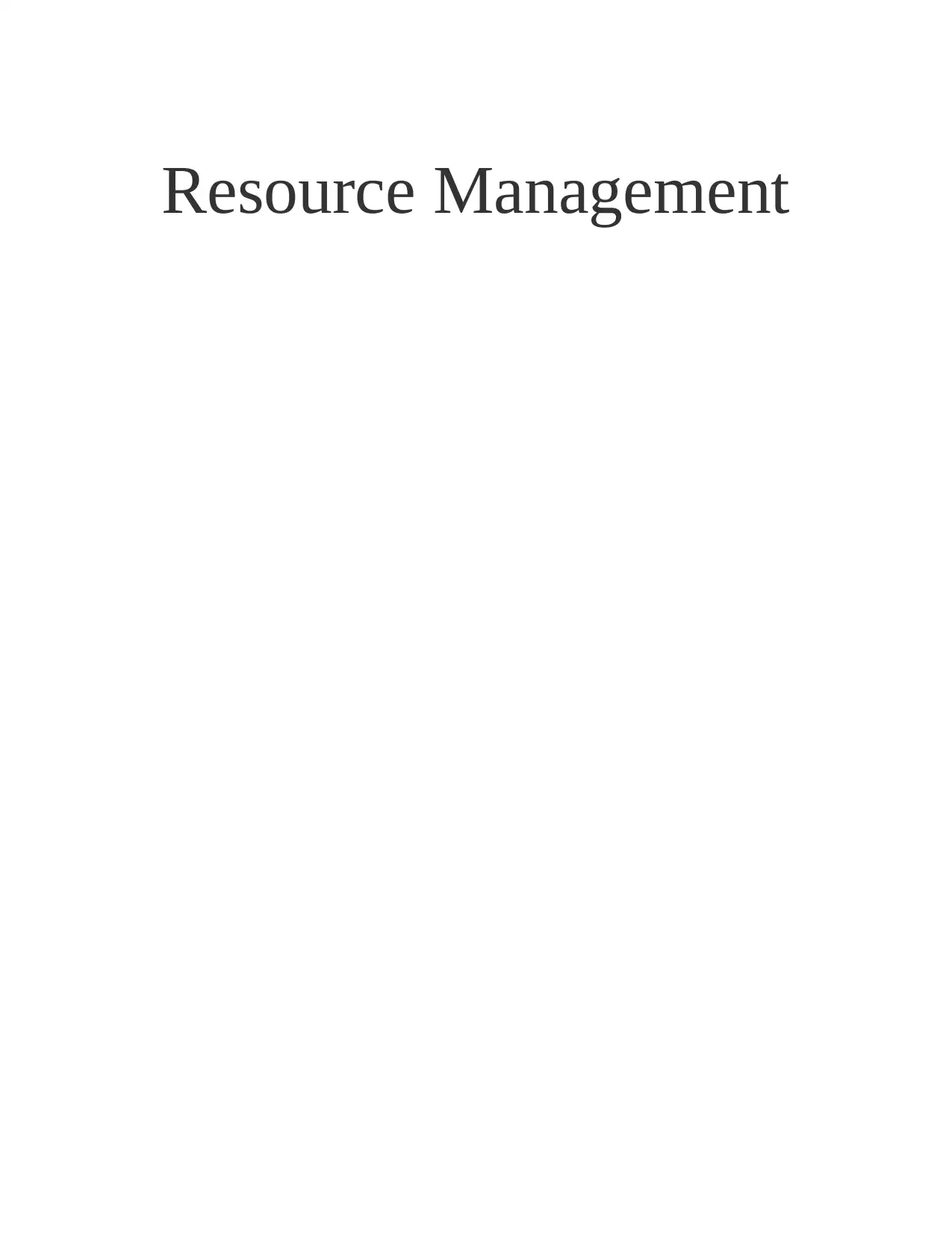
Resource Management
Paraphrase This Document
Need a fresh take? Get an instant paraphrase of this document with our AI Paraphraser
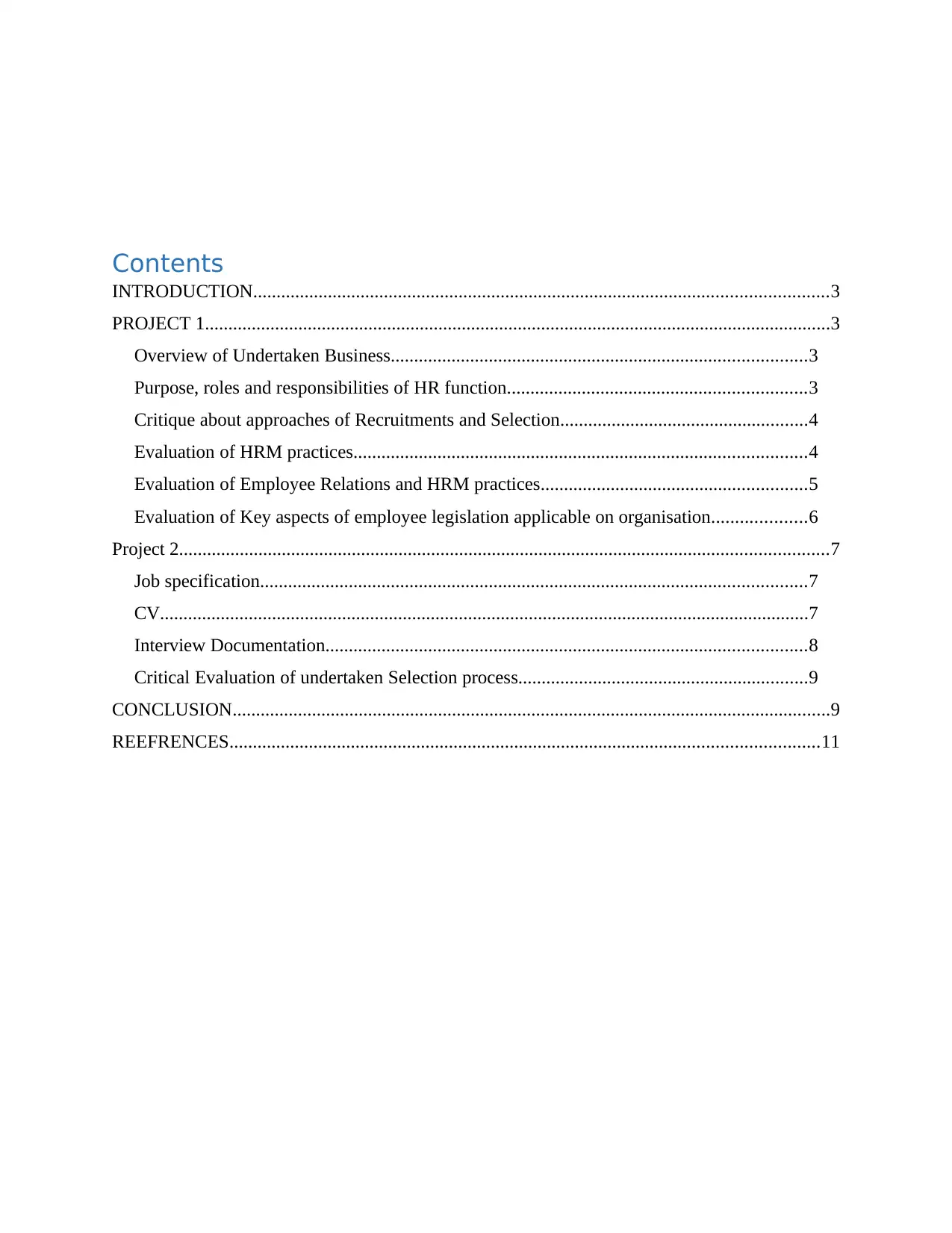
Contents
INTRODUCTION...........................................................................................................................3
PROJECT 1......................................................................................................................................3
Overview of Undertaken Business.........................................................................................3
Purpose, roles and responsibilities of HR function................................................................3
Critique about approaches of Recruitments and Selection.....................................................4
Evaluation of HRM practices.................................................................................................4
Evaluation of Employee Relations and HRM practices.........................................................5
Evaluation of Key aspects of employee legislation applicable on organisation....................6
Project 2...........................................................................................................................................7
Job specification.....................................................................................................................7
CV...........................................................................................................................................7
Interview Documentation.......................................................................................................8
Critical Evaluation of undertaken Selection process..............................................................9
CONCLUSION................................................................................................................................9
REEFRENCES..............................................................................................................................11
INTRODUCTION...........................................................................................................................3
PROJECT 1......................................................................................................................................3
Overview of Undertaken Business.........................................................................................3
Purpose, roles and responsibilities of HR function................................................................3
Critique about approaches of Recruitments and Selection.....................................................4
Evaluation of HRM practices.................................................................................................4
Evaluation of Employee Relations and HRM practices.........................................................5
Evaluation of Key aspects of employee legislation applicable on organisation....................6
Project 2...........................................................................................................................................7
Job specification.....................................................................................................................7
CV...........................................................................................................................................7
Interview Documentation.......................................................................................................8
Critical Evaluation of undertaken Selection process..............................................................9
CONCLUSION................................................................................................................................9
REEFRENCES..............................................................................................................................11
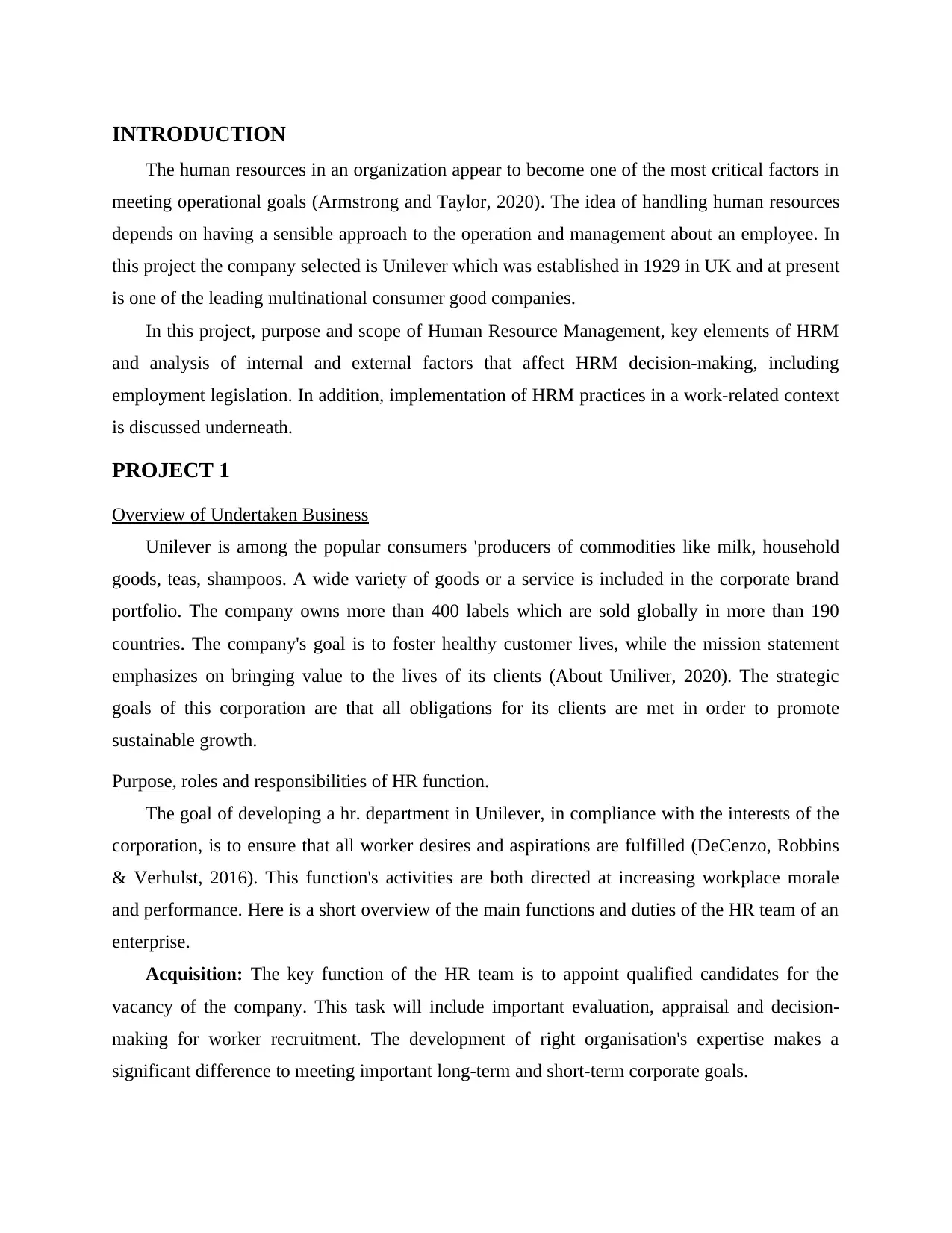
INTRODUCTION
The human resources in an organization appear to become one of the most critical factors in
meeting operational goals (Armstrong and Taylor, 2020). The idea of handling human resources
depends on having a sensible approach to the operation and management about an employee. In
this project the company selected is Unilever which was established in 1929 in UK and at present
is one of the leading multinational consumer good companies.
In this project, purpose and scope of Human Resource Management, key elements of HRM
and analysis of internal and external factors that affect HRM decision-making, including
employment legislation. In addition, implementation of HRM practices in a work-related context
is discussed underneath.
PROJECT 1
Overview of Undertaken Business
Unilever is among the popular consumers 'producers of commodities like milk, household
goods, teas, shampoos. A wide variety of goods or a service is included in the corporate brand
portfolio. The company owns more than 400 labels which are sold globally in more than 190
countries. The company's goal is to foster healthy customer lives, while the mission statement
emphasizes on bringing value to the lives of its clients (About Uniliver, 2020). The strategic
goals of this corporation are that all obligations for its clients are met in order to promote
sustainable growth.
Purpose, roles and responsibilities of HR function.
The goal of developing a hr. department in Unilever, in compliance with the interests of the
corporation, is to ensure that all worker desires and aspirations are fulfilled (DeCenzo, Robbins
& Verhulst, 2016). This function's activities are both directed at increasing workplace morale
and performance. Here is a short overview of the main functions and duties of the HR team of an
enterprise.
Acquisition: The key function of the HR team is to appoint qualified candidates for the
vacancy of the company. This task will include important evaluation, appraisal and decision-
making for worker recruitment. The development of right organisation's expertise makes a
significant difference to meeting important long-term and short-term corporate goals.
The human resources in an organization appear to become one of the most critical factors in
meeting operational goals (Armstrong and Taylor, 2020). The idea of handling human resources
depends on having a sensible approach to the operation and management about an employee. In
this project the company selected is Unilever which was established in 1929 in UK and at present
is one of the leading multinational consumer good companies.
In this project, purpose and scope of Human Resource Management, key elements of HRM
and analysis of internal and external factors that affect HRM decision-making, including
employment legislation. In addition, implementation of HRM practices in a work-related context
is discussed underneath.
PROJECT 1
Overview of Undertaken Business
Unilever is among the popular consumers 'producers of commodities like milk, household
goods, teas, shampoos. A wide variety of goods or a service is included in the corporate brand
portfolio. The company owns more than 400 labels which are sold globally in more than 190
countries. The company's goal is to foster healthy customer lives, while the mission statement
emphasizes on bringing value to the lives of its clients (About Uniliver, 2020). The strategic
goals of this corporation are that all obligations for its clients are met in order to promote
sustainable growth.
Purpose, roles and responsibilities of HR function.
The goal of developing a hr. department in Unilever, in compliance with the interests of the
corporation, is to ensure that all worker desires and aspirations are fulfilled (DeCenzo, Robbins
& Verhulst, 2016). This function's activities are both directed at increasing workplace morale
and performance. Here is a short overview of the main functions and duties of the HR team of an
enterprise.
Acquisition: The key function of the HR team is to appoint qualified candidates for the
vacancy of the company. This task will include important evaluation, appraisal and decision-
making for worker recruitment. The development of right organisation's expertise makes a
significant difference to meeting important long-term and short-term corporate goals.
⊘ This is a preview!⊘
Do you want full access?
Subscribe today to unlock all pages.

Trusted by 1+ million students worldwide
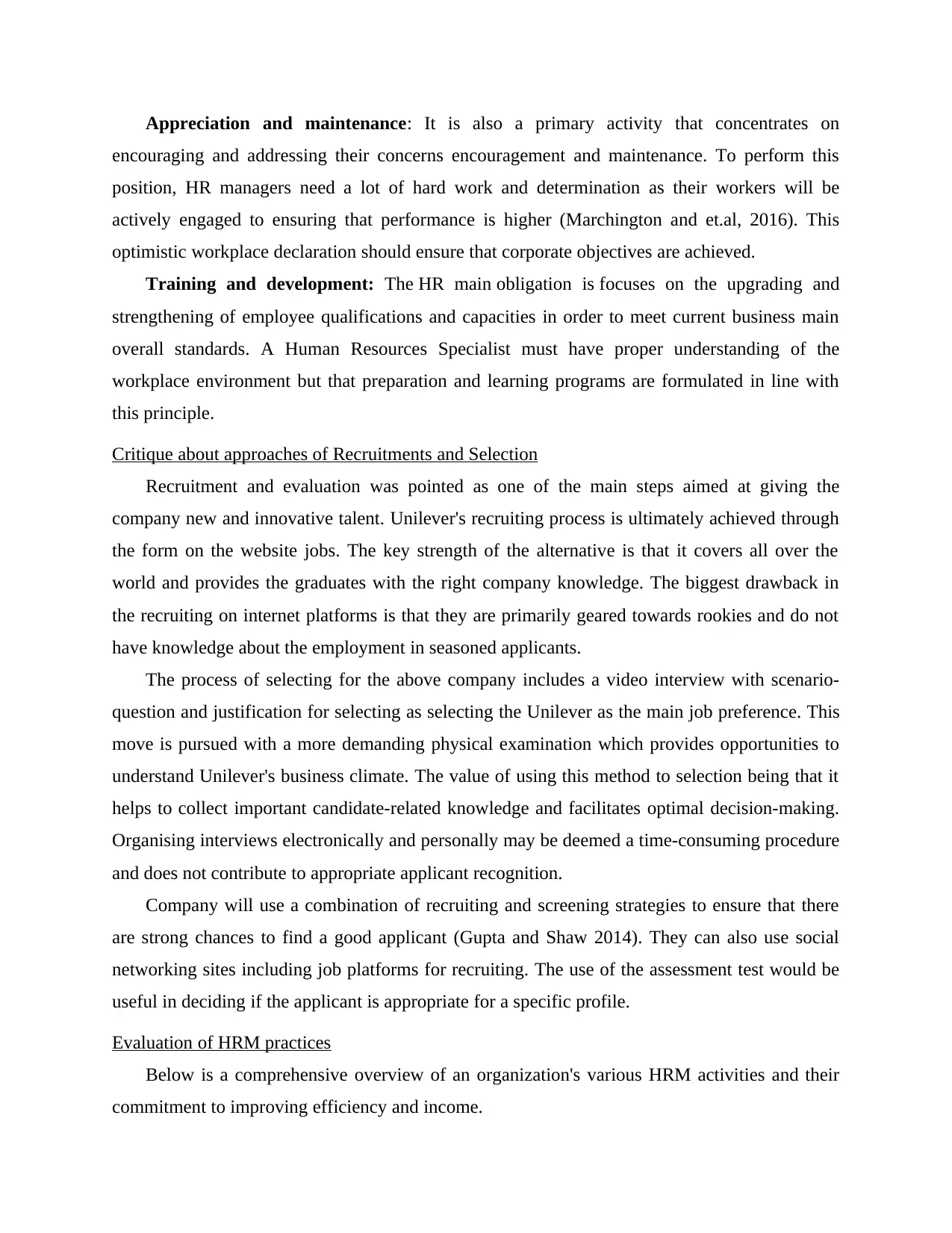
Appreciation and maintenance: It is also a primary activity that concentrates on
encouraging and addressing their concerns encouragement and maintenance. To perform this
position, HR managers need a lot of hard work and determination as their workers will be
actively engaged to ensuring that performance is higher (Marchington and et.al, 2016). This
optimistic workplace declaration should ensure that corporate objectives are achieved.
Training and development: The HR main obligation is focuses on the upgrading and
strengthening of employee qualifications and capacities in order to meet current business main
overall standards. A Human Resources Specialist must have proper understanding of the
workplace environment but that preparation and learning programs are formulated in line with
this principle.
Critique about approaches of Recruitments and Selection
Recruitment and evaluation was pointed as one of the main steps aimed at giving the
company new and innovative talent. Unilever's recruiting process is ultimately achieved through
the form on the website jobs. The key strength of the alternative is that it covers all over the
world and provides the graduates with the right company knowledge. The biggest drawback in
the recruiting on internet platforms is that they are primarily geared towards rookies and do not
have knowledge about the employment in seasoned applicants.
The process of selecting for the above company includes a video interview with scenario-
question and justification for selecting as selecting the Unilever as the main job preference. This
move is pursued with a more demanding physical examination which provides opportunities to
understand Unilever's business climate. The value of using this method to selection being that it
helps to collect important candidate-related knowledge and facilitates optimal decision-making.
Organising interviews electronically and personally may be deemed a time-consuming procedure
and does not contribute to appropriate applicant recognition.
Company will use a combination of recruiting and screening strategies to ensure that there
are strong chances to find a good applicant (Gupta and Shaw 2014). They can also use social
networking sites including job platforms for recruiting. The use of the assessment test would be
useful in deciding if the applicant is appropriate for a specific profile.
Evaluation of HRM practices
Below is a comprehensive overview of an organization's various HRM activities and their
commitment to improving efficiency and income.
encouraging and addressing their concerns encouragement and maintenance. To perform this
position, HR managers need a lot of hard work and determination as their workers will be
actively engaged to ensuring that performance is higher (Marchington and et.al, 2016). This
optimistic workplace declaration should ensure that corporate objectives are achieved.
Training and development: The HR main obligation is focuses on the upgrading and
strengthening of employee qualifications and capacities in order to meet current business main
overall standards. A Human Resources Specialist must have proper understanding of the
workplace environment but that preparation and learning programs are formulated in line with
this principle.
Critique about approaches of Recruitments and Selection
Recruitment and evaluation was pointed as one of the main steps aimed at giving the
company new and innovative talent. Unilever's recruiting process is ultimately achieved through
the form on the website jobs. The key strength of the alternative is that it covers all over the
world and provides the graduates with the right company knowledge. The biggest drawback in
the recruiting on internet platforms is that they are primarily geared towards rookies and do not
have knowledge about the employment in seasoned applicants.
The process of selecting for the above company includes a video interview with scenario-
question and justification for selecting as selecting the Unilever as the main job preference. This
move is pursued with a more demanding physical examination which provides opportunities to
understand Unilever's business climate. The value of using this method to selection being that it
helps to collect important candidate-related knowledge and facilitates optimal decision-making.
Organising interviews electronically and personally may be deemed a time-consuming procedure
and does not contribute to appropriate applicant recognition.
Company will use a combination of recruiting and screening strategies to ensure that there
are strong chances to find a good applicant (Gupta and Shaw 2014). They can also use social
networking sites including job platforms for recruiting. The use of the assessment test would be
useful in deciding if the applicant is appropriate for a specific profile.
Evaluation of HRM practices
Below is a comprehensive overview of an organization's various HRM activities and their
commitment to improving efficiency and income.
Paraphrase This Document
Need a fresh take? Get an instant paraphrase of this document with our AI Paraphraser
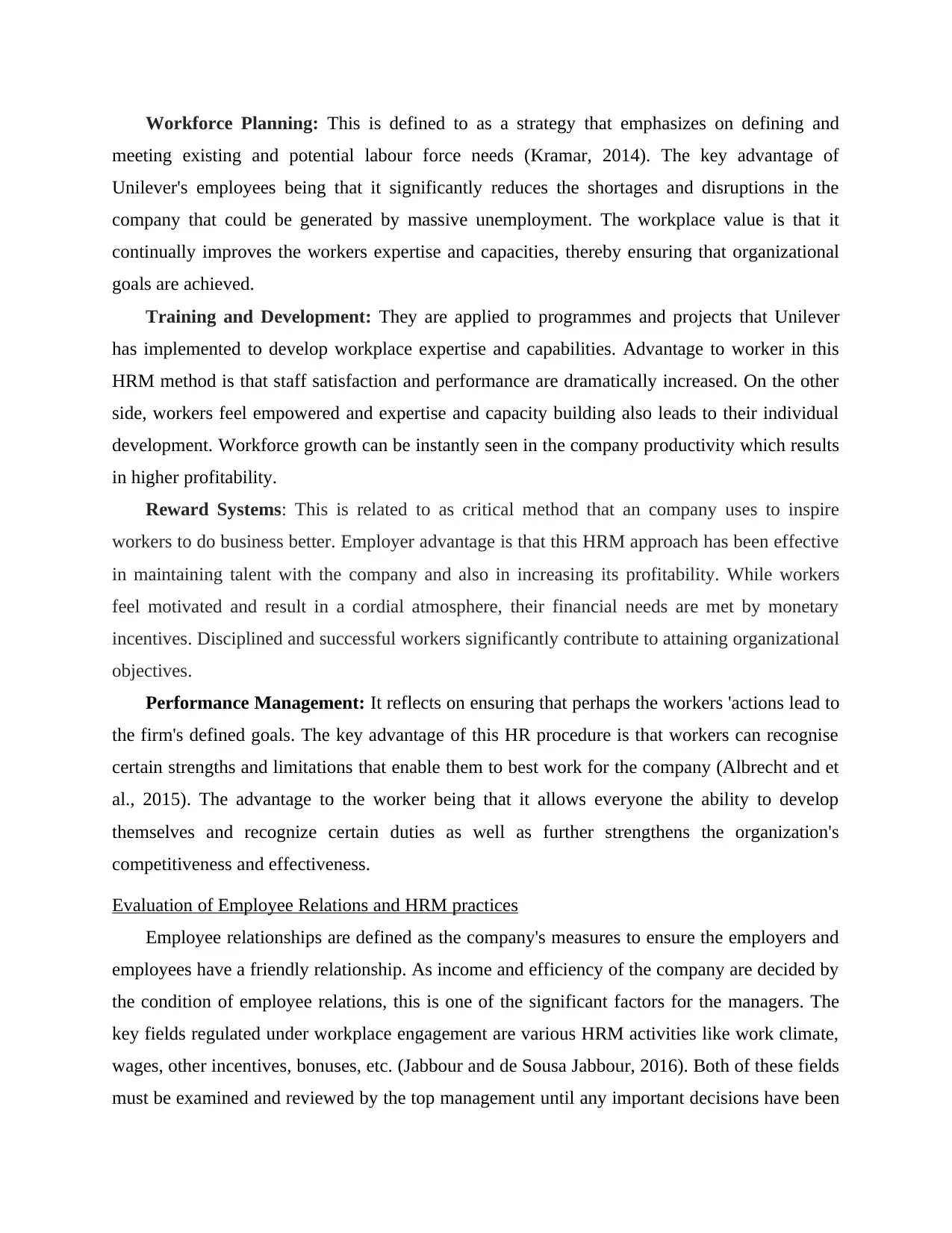
Workforce Planning: This is defined to as a strategy that emphasizes on defining and
meeting existing and potential labour force needs (Kramar, 2014). The key advantage of
Unilever's employees being that it significantly reduces the shortages and disruptions in the
company that could be generated by massive unemployment. The workplace value is that it
continually improves the workers expertise and capacities, thereby ensuring that organizational
goals are achieved.
Training and Development: They are applied to programmes and projects that Unilever
has implemented to develop workplace expertise and capabilities. Advantage to worker in this
HRM method is that staff satisfaction and performance are dramatically increased. On the other
side, workers feel empowered and expertise and capacity building also leads to their individual
development. Workforce growth can be instantly seen in the company productivity which results
in higher profitability.
Reward Systems: This is related to as critical method that an company uses to inspire
workers to do business better. Employer advantage is that this HRM approach has been effective
in maintaining talent with the company and also in increasing its profitability. While workers
feel motivated and result in a cordial atmosphere, their financial needs are met by monetary
incentives. Disciplined and successful workers significantly contribute to attaining organizational
objectives.
Performance Management: It reflects on ensuring that perhaps the workers 'actions lead to
the firm's defined goals. The key advantage of this HR procedure is that workers can recognise
certain strengths and limitations that enable them to best work for the company (Albrecht and et
al., 2015). The advantage to the worker being that it allows everyone the ability to develop
themselves and recognize certain duties as well as further strengthens the organization's
competitiveness and effectiveness.
Evaluation of Employee Relations and HRM practices
Employee relationships are defined as the company's measures to ensure the employers and
employees have a friendly relationship. As income and efficiency of the company are decided by
the condition of employee relations, this is one of the significant factors for the managers. The
key fields regulated under workplace engagement are various HRM activities like work climate,
wages, other incentives, bonuses, etc. (Jabbour and de Sousa Jabbour, 2016). Both of these fields
must be examined and reviewed by the top management until any important decisions have been
meeting existing and potential labour force needs (Kramar, 2014). The key advantage of
Unilever's employees being that it significantly reduces the shortages and disruptions in the
company that could be generated by massive unemployment. The workplace value is that it
continually improves the workers expertise and capacities, thereby ensuring that organizational
goals are achieved.
Training and Development: They are applied to programmes and projects that Unilever
has implemented to develop workplace expertise and capabilities. Advantage to worker in this
HRM method is that staff satisfaction and performance are dramatically increased. On the other
side, workers feel empowered and expertise and capacity building also leads to their individual
development. Workforce growth can be instantly seen in the company productivity which results
in higher profitability.
Reward Systems: This is related to as critical method that an company uses to inspire
workers to do business better. Employer advantage is that this HRM approach has been effective
in maintaining talent with the company and also in increasing its profitability. While workers
feel motivated and result in a cordial atmosphere, their financial needs are met by monetary
incentives. Disciplined and successful workers significantly contribute to attaining organizational
objectives.
Performance Management: It reflects on ensuring that perhaps the workers 'actions lead to
the firm's defined goals. The key advantage of this HR procedure is that workers can recognise
certain strengths and limitations that enable them to best work for the company (Albrecht and et
al., 2015). The advantage to the worker being that it allows everyone the ability to develop
themselves and recognize certain duties as well as further strengthens the organization's
competitiveness and effectiveness.
Evaluation of Employee Relations and HRM practices
Employee relationships are defined as the company's measures to ensure the employers and
employees have a friendly relationship. As income and efficiency of the company are decided by
the condition of employee relations, this is one of the significant factors for the managers. The
key fields regulated under workplace engagement are various HRM activities like work climate,
wages, other incentives, bonuses, etc. (Jabbour and de Sousa Jabbour, 2016). Both of these fields
must be examined and reviewed by the top management until any important decisions have been
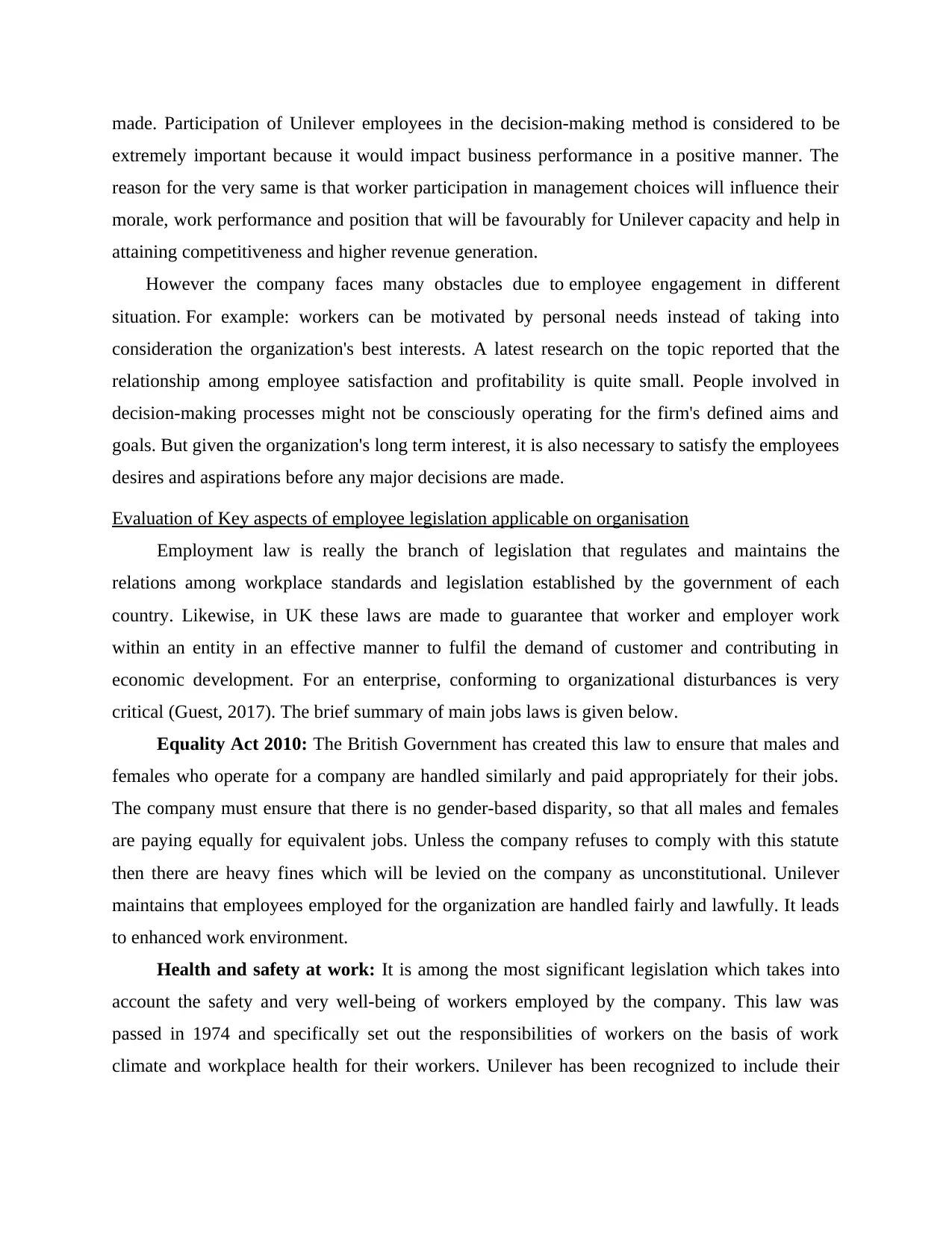
made. Participation of Unilever employees in the decision-making method is considered to be
extremely important because it would impact business performance in a positive manner. The
reason for the very same is that worker participation in management choices will influence their
morale, work performance and position that will be favourably for Unilever capacity and help in
attaining competitiveness and higher revenue generation.
However the company faces many obstacles due to employee engagement in different
situation. For example: workers can be motivated by personal needs instead of taking into
consideration the organization's best interests. A latest research on the topic reported that the
relationship among employee satisfaction and profitability is quite small. People involved in
decision-making processes might not be consciously operating for the firm's defined aims and
goals. But given the organization's long term interest, it is also necessary to satisfy the employees
desires and aspirations before any major decisions are made.
Evaluation of Key aspects of employee legislation applicable on organisation
Employment law is really the branch of legislation that regulates and maintains the
relations among workplace standards and legislation established by the government of each
country. Likewise, in UK these laws are made to guarantee that worker and employer work
within an entity in an effective manner to fulfil the demand of customer and contributing in
economic development. For an enterprise, conforming to organizational disturbances is very
critical (Guest, 2017). The brief summary of main jobs laws is given below.
Equality Act 2010: The British Government has created this law to ensure that males and
females who operate for a company are handled similarly and paid appropriately for their jobs.
The company must ensure that there is no gender-based disparity, so that all males and females
are paying equally for equivalent jobs. Unless the company refuses to comply with this statute
then there are heavy fines which will be levied on the company as unconstitutional. Unilever
maintains that employees employed for the organization are handled fairly and lawfully. It leads
to enhanced work environment.
Health and safety at work: It is among the most significant legislation which takes into
account the safety and very well-being of workers employed by the company. This law was
passed in 1974 and specifically set out the responsibilities of workers on the basis of work
climate and workplace health for their workers. Unilever has been recognized to include their
extremely important because it would impact business performance in a positive manner. The
reason for the very same is that worker participation in management choices will influence their
morale, work performance and position that will be favourably for Unilever capacity and help in
attaining competitiveness and higher revenue generation.
However the company faces many obstacles due to employee engagement in different
situation. For example: workers can be motivated by personal needs instead of taking into
consideration the organization's best interests. A latest research on the topic reported that the
relationship among employee satisfaction and profitability is quite small. People involved in
decision-making processes might not be consciously operating for the firm's defined aims and
goals. But given the organization's long term interest, it is also necessary to satisfy the employees
desires and aspirations before any major decisions are made.
Evaluation of Key aspects of employee legislation applicable on organisation
Employment law is really the branch of legislation that regulates and maintains the
relations among workplace standards and legislation established by the government of each
country. Likewise, in UK these laws are made to guarantee that worker and employer work
within an entity in an effective manner to fulfil the demand of customer and contributing in
economic development. For an enterprise, conforming to organizational disturbances is very
critical (Guest, 2017). The brief summary of main jobs laws is given below.
Equality Act 2010: The British Government has created this law to ensure that males and
females who operate for a company are handled similarly and paid appropriately for their jobs.
The company must ensure that there is no gender-based disparity, so that all males and females
are paying equally for equivalent jobs. Unless the company refuses to comply with this statute
then there are heavy fines which will be levied on the company as unconstitutional. Unilever
maintains that employees employed for the organization are handled fairly and lawfully. It leads
to enhanced work environment.
Health and safety at work: It is among the most significant legislation which takes into
account the safety and very well-being of workers employed by the company. This law was
passed in 1974 and specifically set out the responsibilities of workers on the basis of work
climate and workplace health for their workers. Unilever has been recognized to include their
⊘ This is a preview!⊘
Do you want full access?
Subscribe today to unlock all pages.

Trusted by 1+ million students worldwide
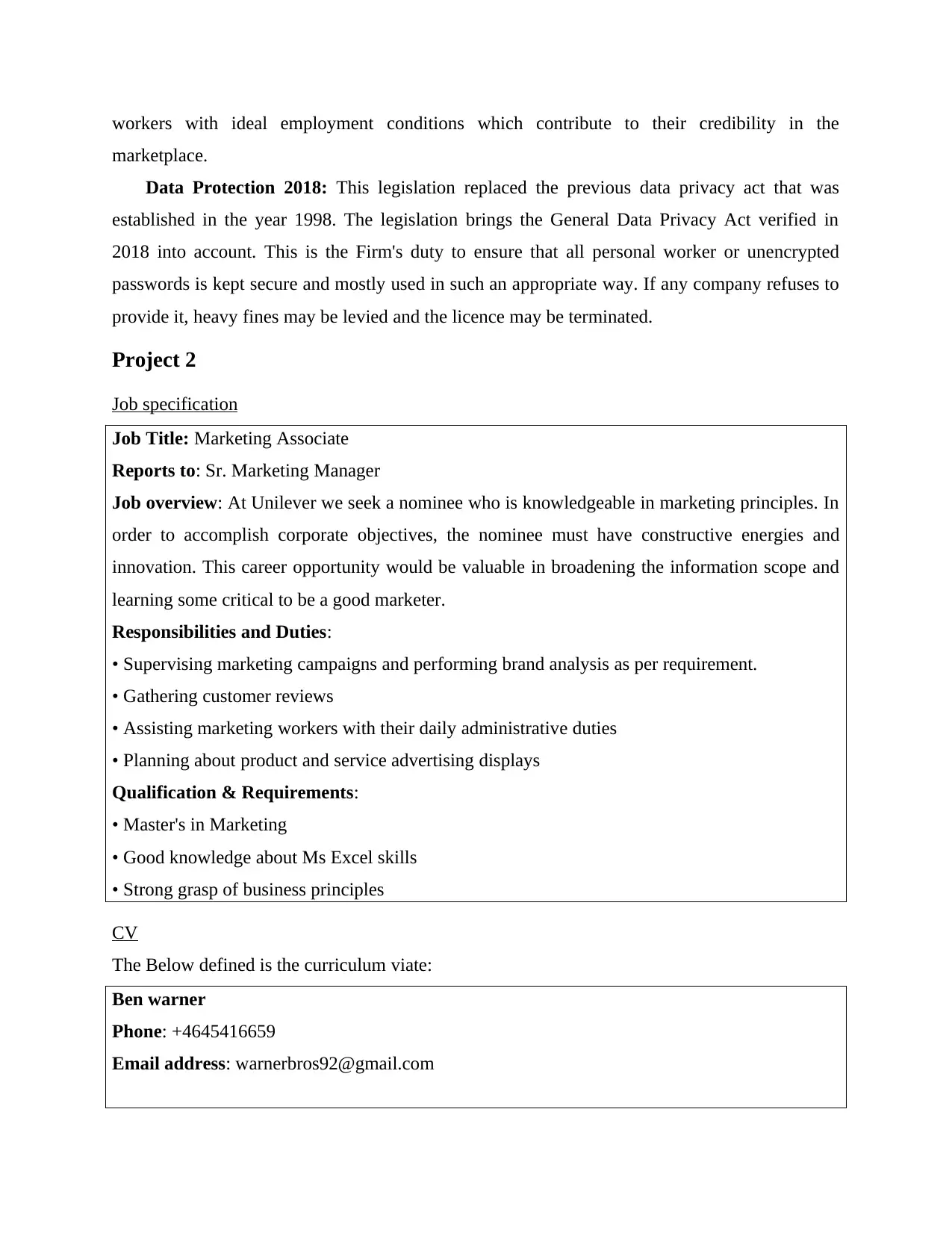
workers with ideal employment conditions which contribute to their credibility in the
marketplace.
Data Protection 2018: This legislation replaced the previous data privacy act that was
established in the year 1998. The legislation brings the General Data Privacy Act verified in
2018 into account. This is the Firm's duty to ensure that all personal worker or unencrypted
passwords is kept secure and mostly used in such an appropriate way. If any company refuses to
provide it, heavy fines may be levied and the licence may be terminated.
Project 2
Job specification
Job Title: Marketing Associate
Reports to: Sr. Marketing Manager
Job overview: At Unilever we seek a nominee who is knowledgeable in marketing principles. In
order to accomplish corporate objectives, the nominee must have constructive energies and
innovation. This career opportunity would be valuable in broadening the information scope and
learning some critical to be a good marketer.
Responsibilities and Duties:
• Supervising marketing campaigns and performing brand analysis as per requirement.
• Gathering customer reviews
• Assisting marketing workers with their daily administrative duties
• Planning about product and service advertising displays
Qualification & Requirements:
• Master's in Marketing
• Good knowledge about Ms Excel skills
• Strong grasp of business principles
CV
The Below defined is the curriculum viate:
Ben warner
Phone: +4645416659
Email address: warnerbros92@gmail.com
marketplace.
Data Protection 2018: This legislation replaced the previous data privacy act that was
established in the year 1998. The legislation brings the General Data Privacy Act verified in
2018 into account. This is the Firm's duty to ensure that all personal worker or unencrypted
passwords is kept secure and mostly used in such an appropriate way. If any company refuses to
provide it, heavy fines may be levied and the licence may be terminated.
Project 2
Job specification
Job Title: Marketing Associate
Reports to: Sr. Marketing Manager
Job overview: At Unilever we seek a nominee who is knowledgeable in marketing principles. In
order to accomplish corporate objectives, the nominee must have constructive energies and
innovation. This career opportunity would be valuable in broadening the information scope and
learning some critical to be a good marketer.
Responsibilities and Duties:
• Supervising marketing campaigns and performing brand analysis as per requirement.
• Gathering customer reviews
• Assisting marketing workers with their daily administrative duties
• Planning about product and service advertising displays
Qualification & Requirements:
• Master's in Marketing
• Good knowledge about Ms Excel skills
• Strong grasp of business principles
CV
The Below defined is the curriculum viate:
Ben warner
Phone: +4645416659
Email address: warnerbros92@gmail.com
Paraphrase This Document
Need a fresh take? Get an instant paraphrase of this document with our AI Paraphraser
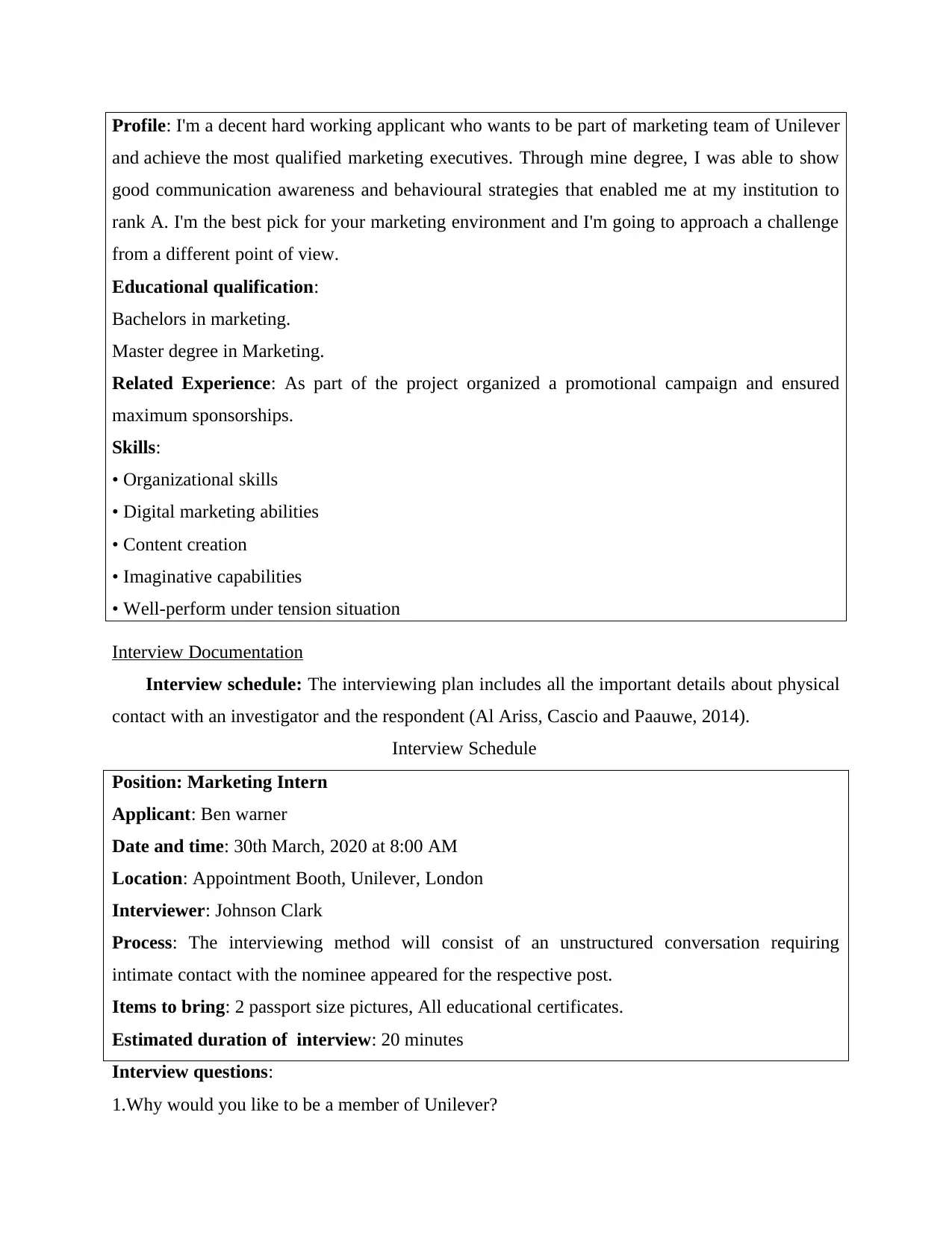
Profile: I'm a decent hard working applicant who wants to be part of marketing team of Unilever
and achieve the most qualified marketing executives. Through mine degree, I was able to show
good communication awareness and behavioural strategies that enabled me at my institution to
rank A. I'm the best pick for your marketing environment and I'm going to approach a challenge
from a different point of view.
Educational qualification:
Bachelors in marketing.
Master degree in Marketing.
Related Experience: As part of the project organized a promotional campaign and ensured
maximum sponsorships.
Skills:
• Organizational skills
• Digital marketing abilities
• Content creation
• Imaginative capabilities
• Well-perform under tension situation
Interview Documentation
Interview schedule: The interviewing plan includes all the important details about physical
contact with an investigator and the respondent (Al Ariss, Cascio and Paauwe, 2014).
Interview Schedule
Position: Marketing Intern
Applicant: Ben warner
Date and time: 30th March, 2020 at 8:00 AM
Location: Appointment Booth, Unilever, London
Interviewer: Johnson Clark
Process: The interviewing method will consist of an unstructured conversation requiring
intimate contact with the nominee appeared for the respective post.
Items to bring: 2 passport size pictures, All educational certificates.
Estimated duration of interview: 20 minutes
Interview questions:
1.Why would you like to be a member of Unilever?
and achieve the most qualified marketing executives. Through mine degree, I was able to show
good communication awareness and behavioural strategies that enabled me at my institution to
rank A. I'm the best pick for your marketing environment and I'm going to approach a challenge
from a different point of view.
Educational qualification:
Bachelors in marketing.
Master degree in Marketing.
Related Experience: As part of the project organized a promotional campaign and ensured
maximum sponsorships.
Skills:
• Organizational skills
• Digital marketing abilities
• Content creation
• Imaginative capabilities
• Well-perform under tension situation
Interview Documentation
Interview schedule: The interviewing plan includes all the important details about physical
contact with an investigator and the respondent (Al Ariss, Cascio and Paauwe, 2014).
Interview Schedule
Position: Marketing Intern
Applicant: Ben warner
Date and time: 30th March, 2020 at 8:00 AM
Location: Appointment Booth, Unilever, London
Interviewer: Johnson Clark
Process: The interviewing method will consist of an unstructured conversation requiring
intimate contact with the nominee appeared for the respective post.
Items to bring: 2 passport size pictures, All educational certificates.
Estimated duration of interview: 20 minutes
Interview questions:
1.Why would you like to be a member of Unilever?
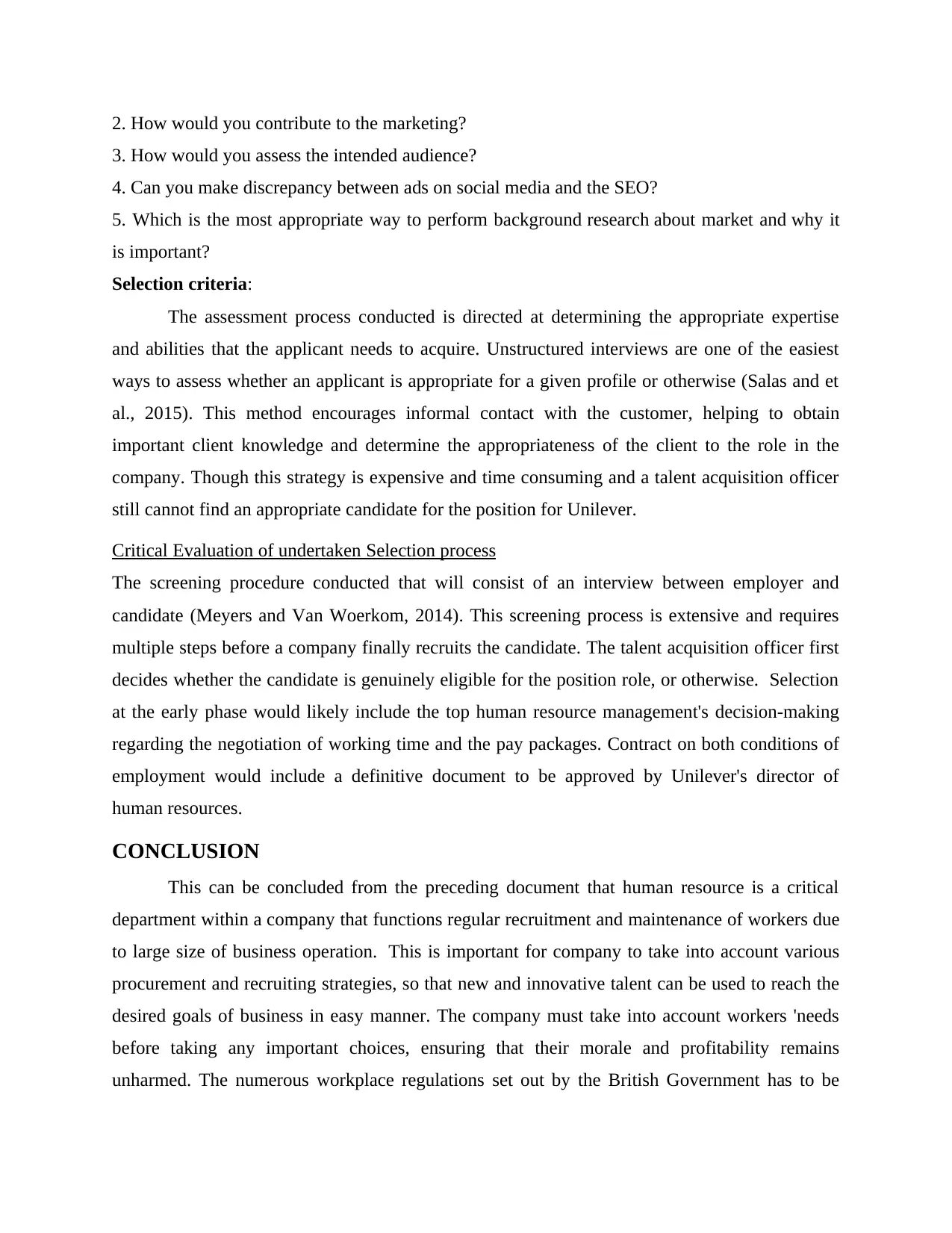
2. How would you contribute to the marketing?
3. How would you assess the intended audience?
4. Can you make discrepancy between ads on social media and the SEO?
5. Which is the most appropriate way to perform background research about market and why it
is important?
Selection criteria:
The assessment process conducted is directed at determining the appropriate expertise
and abilities that the applicant needs to acquire. Unstructured interviews are one of the easiest
ways to assess whether an applicant is appropriate for a given profile or otherwise (Salas and et
al., 2015). This method encourages informal contact with the customer, helping to obtain
important client knowledge and determine the appropriateness of the client to the role in the
company. Though this strategy is expensive and time consuming and a talent acquisition officer
still cannot find an appropriate candidate for the position for Unilever.
Critical Evaluation of undertaken Selection process
The screening procedure conducted that will consist of an interview between employer and
candidate (Meyers and Van Woerkom, 2014). This screening process is extensive and requires
multiple steps before a company finally recruits the candidate. The talent acquisition officer first
decides whether the candidate is genuinely eligible for the position role, or otherwise. Selection
at the early phase would likely include the top human resource management's decision-making
regarding the negotiation of working time and the pay packages. Contract on both conditions of
employment would include a definitive document to be approved by Unilever's director of
human resources.
CONCLUSION
This can be concluded from the preceding document that human resource is a critical
department within a company that functions regular recruitment and maintenance of workers due
to large size of business operation. This is important for company to take into account various
procurement and recruiting strategies, so that new and innovative talent can be used to reach the
desired goals of business in easy manner. The company must take into account workers 'needs
before taking any important choices, ensuring that their morale and profitability remains
unharmed. The numerous workplace regulations set out by the British Government has to be
3. How would you assess the intended audience?
4. Can you make discrepancy between ads on social media and the SEO?
5. Which is the most appropriate way to perform background research about market and why it
is important?
Selection criteria:
The assessment process conducted is directed at determining the appropriate expertise
and abilities that the applicant needs to acquire. Unstructured interviews are one of the easiest
ways to assess whether an applicant is appropriate for a given profile or otherwise (Salas and et
al., 2015). This method encourages informal contact with the customer, helping to obtain
important client knowledge and determine the appropriateness of the client to the role in the
company. Though this strategy is expensive and time consuming and a talent acquisition officer
still cannot find an appropriate candidate for the position for Unilever.
Critical Evaluation of undertaken Selection process
The screening procedure conducted that will consist of an interview between employer and
candidate (Meyers and Van Woerkom, 2014). This screening process is extensive and requires
multiple steps before a company finally recruits the candidate. The talent acquisition officer first
decides whether the candidate is genuinely eligible for the position role, or otherwise. Selection
at the early phase would likely include the top human resource management's decision-making
regarding the negotiation of working time and the pay packages. Contract on both conditions of
employment would include a definitive document to be approved by Unilever's director of
human resources.
CONCLUSION
This can be concluded from the preceding document that human resource is a critical
department within a company that functions regular recruitment and maintenance of workers due
to large size of business operation. This is important for company to take into account various
procurement and recruiting strategies, so that new and innovative talent can be used to reach the
desired goals of business in easy manner. The company must take into account workers 'needs
before taking any important choices, ensuring that their morale and profitability remains
unharmed. The numerous workplace regulations set out by the British Government has to be
⊘ This is a preview!⊘
Do you want full access?
Subscribe today to unlock all pages.

Trusted by 1+ million students worldwide
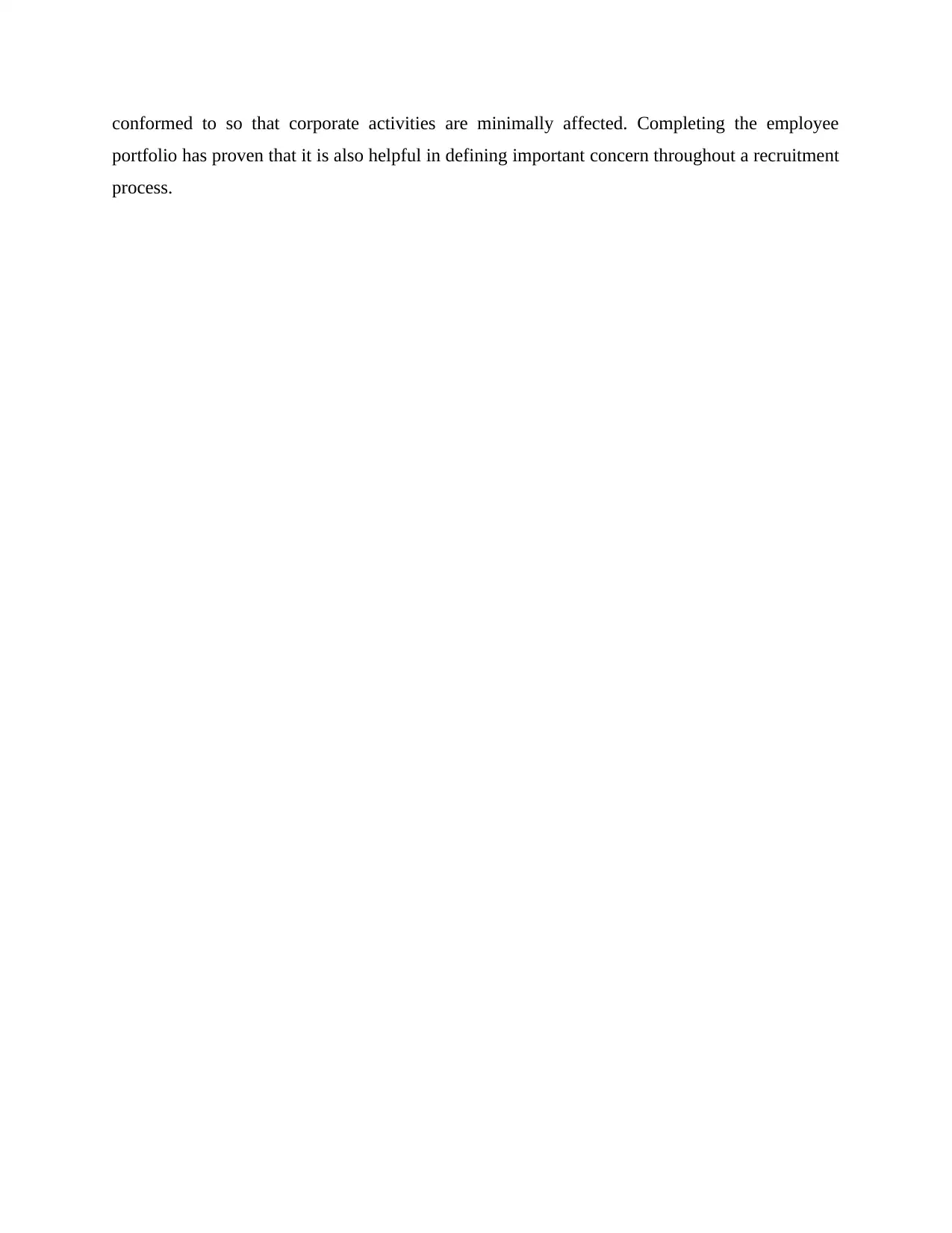
conformed to so that corporate activities are minimally affected. Completing the employee
portfolio has proven that it is also helpful in defining important concern throughout a recruitment
process.
portfolio has proven that it is also helpful in defining important concern throughout a recruitment
process.
Paraphrase This Document
Need a fresh take? Get an instant paraphrase of this document with our AI Paraphraser
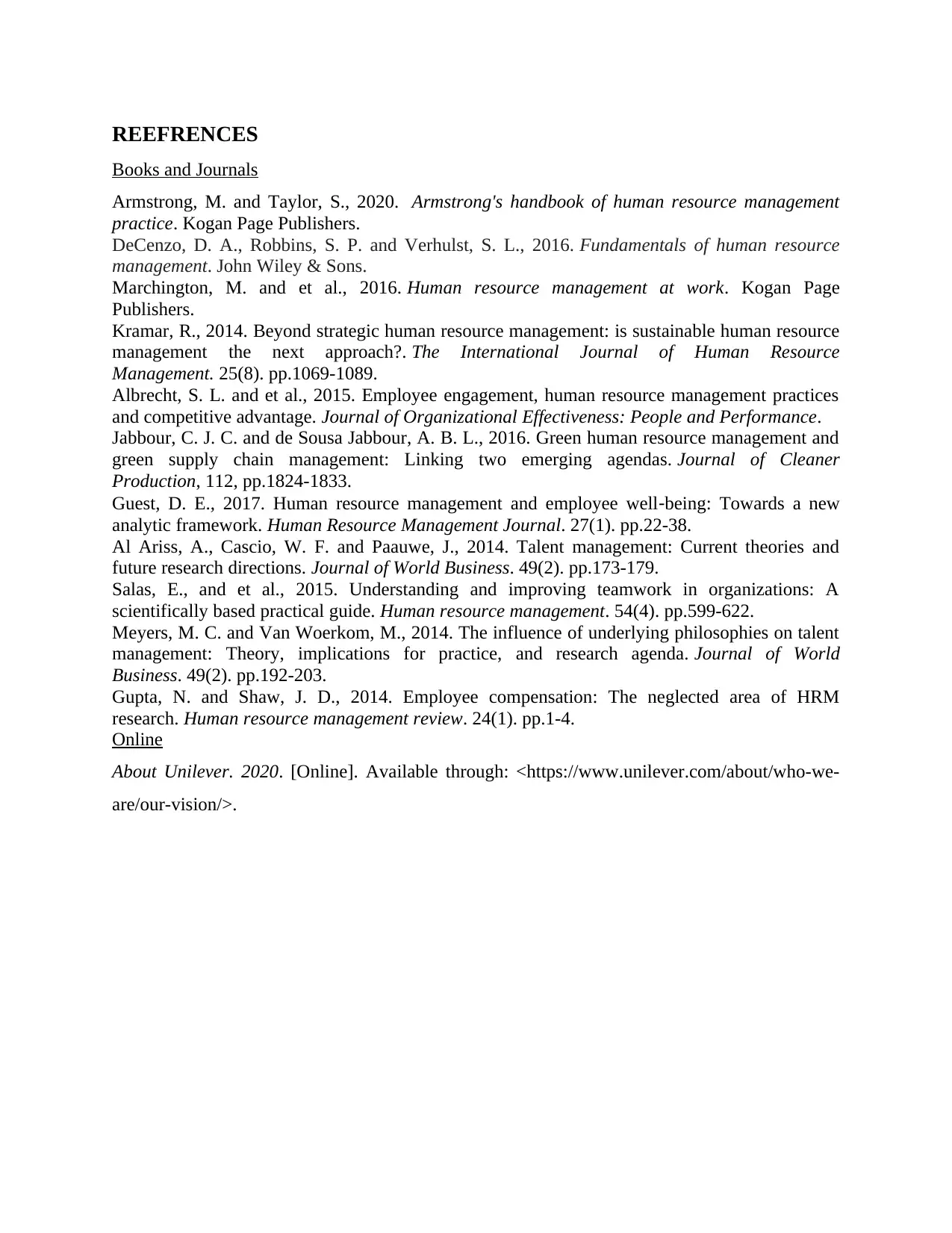
REEFRENCES
Books and Journals
Armstrong, M. and Taylor, S., 2020. Armstrong's handbook of human resource management
practice. Kogan Page Publishers.
DeCenzo, D. A., Robbins, S. P. and Verhulst, S. L., 2016. Fundamentals of human resource
management. John Wiley & Sons.
Marchington, M. and et al., 2016. Human resource management at work. Kogan Page
Publishers.
Kramar, R., 2014. Beyond strategic human resource management: is sustainable human resource
management the next approach?. The International Journal of Human Resource
Management. 25(8). pp.1069-1089.
Albrecht, S. L. and et al., 2015. Employee engagement, human resource management practices
and competitive advantage. Journal of Organizational Effectiveness: People and Performance.
Jabbour, C. J. C. and de Sousa Jabbour, A. B. L., 2016. Green human resource management and
green supply chain management: Linking two emerging agendas. Journal of Cleaner
Production, 112, pp.1824-1833.
Guest, D. E., 2017. Human resource management and employee well‐being: Towards a new
analytic framework. Human Resource Management Journal. 27(1). pp.22-38.
Al Ariss, A., Cascio, W. F. and Paauwe, J., 2014. Talent management: Current theories and
future research directions. Journal of World Business. 49(2). pp.173-179.
Salas, E., and et al., 2015. Understanding and improving teamwork in organizations: A
scientifically based practical guide. Human resource management. 54(4). pp.599-622.
Meyers, M. C. and Van Woerkom, M., 2014. The influence of underlying philosophies on talent
management: Theory, implications for practice, and research agenda. Journal of World
Business. 49(2). pp.192-203.
Gupta, N. and Shaw, J. D., 2014. Employee compensation: The neglected area of HRM
research. Human resource management review. 24(1). pp.1-4.
Online
About Unilever. 2020. [Online]. Available through: <https://www.unilever.com/about/who-we-
are/our-vision/>.
Books and Journals
Armstrong, M. and Taylor, S., 2020. Armstrong's handbook of human resource management
practice. Kogan Page Publishers.
DeCenzo, D. A., Robbins, S. P. and Verhulst, S. L., 2016. Fundamentals of human resource
management. John Wiley & Sons.
Marchington, M. and et al., 2016. Human resource management at work. Kogan Page
Publishers.
Kramar, R., 2014. Beyond strategic human resource management: is sustainable human resource
management the next approach?. The International Journal of Human Resource
Management. 25(8). pp.1069-1089.
Albrecht, S. L. and et al., 2015. Employee engagement, human resource management practices
and competitive advantage. Journal of Organizational Effectiveness: People and Performance.
Jabbour, C. J. C. and de Sousa Jabbour, A. B. L., 2016. Green human resource management and
green supply chain management: Linking two emerging agendas. Journal of Cleaner
Production, 112, pp.1824-1833.
Guest, D. E., 2017. Human resource management and employee well‐being: Towards a new
analytic framework. Human Resource Management Journal. 27(1). pp.22-38.
Al Ariss, A., Cascio, W. F. and Paauwe, J., 2014. Talent management: Current theories and
future research directions. Journal of World Business. 49(2). pp.173-179.
Salas, E., and et al., 2015. Understanding and improving teamwork in organizations: A
scientifically based practical guide. Human resource management. 54(4). pp.599-622.
Meyers, M. C. and Van Woerkom, M., 2014. The influence of underlying philosophies on talent
management: Theory, implications for practice, and research agenda. Journal of World
Business. 49(2). pp.192-203.
Gupta, N. and Shaw, J. D., 2014. Employee compensation: The neglected area of HRM
research. Human resource management review. 24(1). pp.1-4.
Online
About Unilever. 2020. [Online]. Available through: <https://www.unilever.com/about/who-we-
are/our-vision/>.
1 out of 11
Related Documents
Your All-in-One AI-Powered Toolkit for Academic Success.
+13062052269
info@desklib.com
Available 24*7 on WhatsApp / Email
![[object Object]](/_next/static/media/star-bottom.7253800d.svg)
Unlock your academic potential
Copyright © 2020–2025 A2Z Services. All Rights Reserved. Developed and managed by ZUCOL.



